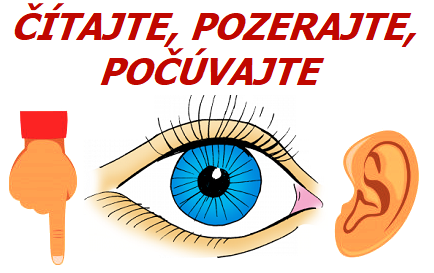11 Človek a príroda - HUMAN RACE AND NATURE :)
Vytvorené: 27. 02. 2014 Tlačiť
a) Seasons of the year
There are four seasons of the year - spring, summer, autumn and winter. Every season of the year lasts for three months.
Spring officially begins on March 21st. The days get longer and warmer gradually so that plants begin to grow again. The first flowers appear for example snowdrops and daffodils. All the landscape turns green. The weather is still very uncertain in April. Children like spring because of Easter.
Spring is followed by summer. Summer begins on June 21st. It is the warmest season of the year and the highest temperatures occur in July and August when the temperature can go up to 35 degrees centigrade. There are usually storms after a sultry day. Children don´t have to go to school because they have summer holiday. Many people travel abroad – they go to the sea or in the mountains.
Autumn, which begins on September 23rd, is probably best known as the season when the leaves on the trees change their colours. At the beginning of autumn the weather is usually still nice and warm – this period is called indian summer.The days are shorter and nights longer than in summer. The weather gets colder gradually and it is usually cloudy and foggy. People gather fruits and vegetables in their gardens. When it is windy, children can enjoy flying a kite.
Winter begins in December and it is the coldest season of the year. The main sings of winter are cold days and snow. January is usually the coldest month of the year with normal temperatures of around freezing to about 5 degrees. People can do winter sports, such as skiing, ice-skating or snowboarding. We connect winter with Christmas.
b) Wildlife around us – fauna
There are many animals living in the nature. We can sight deer, fox, squirrel, snake, hedgehog, hare, wild boar or badger in the forest. Animals flying in the air are birds and insect. We can mention eagles, crows, magpies from birds and bees, flies and butterflies from insect. Many animals live in water, for example fish like carp, pike or trout and frogs, swans and beavers live there too. People can keep domesticated animals for example cows, pigs or sheep. A cow gives us milk and meat. We can keep also animals like dogs, cats or hamsters at home. We have a special relationship to them. A part of animals lives in a ZOO. Some people claim zoos should be abolished because animals are kept in cages and live in conditions that are very different from their natural ones, others think that zoos are good idea, especially children love it, because it is great entertainment for them and they can learn a lot in there. Zoos are useful for endangered animals because there can be save some nearly extinct species. Very popular are tigers, bears, monkeys, camels, elephants, leopards or lions.
c) Environment and natural disasters
We need three basic elements for our lives: water, air and land. All pollution is caused by chemical substances getting into our water, soil and air. These chemicals are not just from factories but from common products of daily usage such as laundry detergents, pesticides and fertilizers. All these chemicals gradually get into the atmosphere or leak into the soil and pollute our water. Air is polluted by the increasing number of cars which emit exhaust fumes. Factories produce carbon dioxide, lead poisons, radioactive particles which get into the air and later can fall back as acid rain. Acid rain damages buildings, kills trees and fish and makes the soil infertile.
The ozone layer helps to protect our Earth from the sun’s ultraviolet radiation, which is responsible for sunburn, snow blindness, eye damage or skin cancer. Scientists have recently discovered holes in the ozone layer. This holes are caused mainly by CFCs which are used in refrigeration technology.
The greenhouse effect is caused by accumulation of certain gases in the Earth's atmosphere. These gases are generated primarily by burning fossil fuels. Because of their accumulation they create a layer in the upper atmosphere and stop the heat reflected from the Earth's surface. This phenom is responsible for global warming. The main results of global warming are melting of mountain glaciers and icebergs, rising of temperature and an expansion of ocean water. The melting of glaciers and rising of temperature can cause drought in some parts of the Earth and floods in others. Some animal species could become endangered or extinct because of these changes. Changes on the Earth may also cause tornados and earthquakes.
d) Protection of environment
Everybody should protect environment because the changes on the Earth can lead to the doom. There are many things how we can improve environment around us. We should recycle the waste and try not to use materials that can´t be recycled. People shouldn’t drive car too much but rather use a bicycle or go on foot. It is important to use our cars and transport more efficiently. More people can use one car together instead of driving their own car. In order to protect our environment, we should buy unleaded petrol and catalytic converters. Everybody can save electricity by turning off the lights, TV or computer when he doesn´t need them. It is also necessary to save water. A good way to reduce the greenhouse gases is planting of trees. We should build more power stations, which would be not so harmful to the Earth like a wind-power station, a solar-power station or a hydro-power station.
National parks and nature reserves can help to protect endangered animals and plants.
There are organizations which look after and fight for the protection of the environment. These are for example Green Peace and Children of the Earth. They organize public campaigns and they inform the people about the importance of the environmental protection.
e) Influence of environment on the human life
If we continue to pollute our environment, the life on this planet will be in danger. People, animals, birds and plants can´t exist without basic components which are necessary for their existence – air, water, soil and the sun. If we don´t stop destroying the Earth, we will kill ourselves.
![]()
· Simulácie z fyziky· O Slovensku po slovensky· Slovenské kroje· Kurz národopisu· Diela maliarov· Kontrolné otázky, Domáce úlohy, E-testy - Priemysel· Odborné obrázkové slovníky· Poradňa žiadaného učiteľa· Rýchlokurz Angličtiny. Rozprávky (v mp3)· PREHĽADY (PRIBUDLO, ČO JE NOVÉ?)Seriály:· História sveta (1÷6)· História Slovenska (1÷5)· História módy (1÷5).
Členstvo na portáli
Poznámka pre autora
Copyright © 2013-2025 Wesline, s.r.o. Všetky práva vyhradené. Mapa stránky ako tabuľka | Kurzy | Prehľady |






